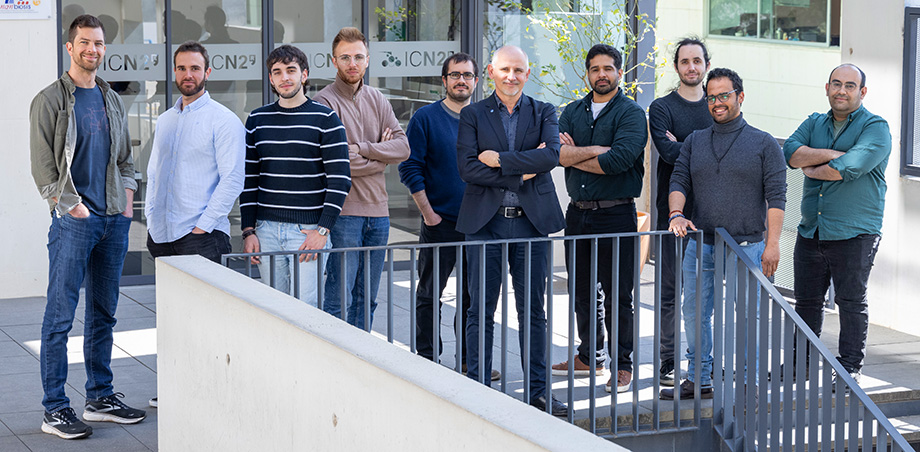Theoretical and Computational Nanoscience
Group Leader: Stephan Roche

Main Research Lines
Theoretical research on quantum transport phenomena in topological quantum matter (topological insulators, Weyl semimetals) in equilibrium and non-equilibrium regimes
Spin dynamics and entanglement properties in Dirac matter (graphene, two-dimensional materials) and van der Waals heterostructures, with the search for new paradigm of quantum information manipulation
Artificial Intelligence and machine learning techniques to accelerate the building of realistic and adaptative structural and electronic models of highly disordered materials and heterostructures
Predictive modelling and multiscale numerical simulation of complex nanomaterials and quantum nanodevices
Molecular dynamics, thermal transport properties and thermoelectricity in nanomaterials of interest for microelectronics (amorphous graphene and boron nitride)

In 2022 the group published the following relevant works:
Two-dimensional materials prospects for non-volatile spintronic memories
After more than a decade leading the European task force in 2D materials-based spintronics, Prof. Roche has coordinated a major overview of the state-of-the-art of the field and of the challenges currently faced in the development of non-volatile memories in general and, specifically, of those employing spintronic mechanisms such as spin-transfer torque (STT) and spin-orbit torque (SOT). Collaborating with Graphene Flagship’s partners CNRS, CEA and Thales (France) and imec (Belgium), researchers at the National University of Singapore, as well as industrial partners at Samsung Electronics (South Korea) and Global Foundries (Singapore), an in-depth discussion about the advantages of the co-integration of 2D materials in these technologies has been provided, giving a panoramic of the improvements already achieved as well as a prospect of the many advances that further research can produce, in particular in SOT-RAMs. A possible timeline of progress during the next decade is also traced.
Electrical control of spin-polarized topological currents in monolayer WTe2
In this work, the TCN group and collaborators have demonstrated the possibility for fully coherent electrical manipulation of the spin orientation of topologically protected edge states in a low-symmetry quantum spin Hall insulator. By using a combination of ab initio simulations, symmetry-based modelling, and large-scale calculations of the spin Hall conductivity performed using in-house LSQUANT (www.lsquant.org), it is shown that small electric fields can efficiently vary the spin textures of edge currents in monolayer 1T’-WTe2 by up to a 90-degree spin rotation, without jeopardizing their topological character. These findings suggest a new kind of gate-controllable spin-based device, topologically protected against disorder and of relevance for the development of topological spintronics.
Unveiling the multiradical character of the biphenylene network and its anisotropic charge transport
Recent progress in the on-surface synthesis and characterization of nanomaterials is facilitating the realization of new carbon allotropes, such as nanoporous graphenes, graphynes, and 2D π-conjugated polymers, following experimental pioneering work at ICN2. One of the latest examples is the biphenylene network (BPN), which was recently fabricated on gold and characterized with atomic precision. This gapless 2D organic material presents uncommon metallic conduction, which could help develop innovative carbon-based electronics. Using first principles calculations and quantum transport simulations, the TCN group has provided new insights into some fundamental properties of BPN, which are key for its further technological exploitation. We predict that BPN hosts an unprecedented spin-polarized multiradical ground state, which has important implications for the chemical reactivity of the 2D material under practical use conditions.
Toward optimized charge transport in multilayer reduced graphene oxides
In the context of graphene-based composite applications, a complete understanding of charge conduction in multilayer reduced graphene oxides (rGO) is highly desirable. However, these rGO compounds are characterized by multiple and different sources of disorder depending on the chemical method used for their synthesis. Most importantly, the precise role of interlayer interaction in promoting or jeopardizing electronic flow remains unclear. Thanks to the development of a multiscale computational approach combining first-principles calculations with large-scale transport simulations, the TCN group and co-workers have discovered interesting transport scaling laws in multilayer rGO, explaining why diffusion worsens with increasing film thickness. In contrast, contacted films are found to exhibit an opposite trend when the mean free path becomes shorter than the channel length, since conduction becomes predominantly driven by interlayer hopping. These predictions are favourably compared with experimental data and open a road toward the optimization of graphene-based composites with improved electrical conduction.
Group Leader

Stephan Roche
ICREA Research Professor
stephan.roche@icn2.cat
ICREA Prof. Stephan Roche is working at the Catalan Institute of Nanosciences and Nanotechnology (ICN2) and BIST. He leads the Theoretical and Computational Nanoscience group which focuses on physics of Dirac materials (graphene and topological insulators) and 2D materials-based van der Waals heterostructures. He pioneered the development of linear scaling quantum transport approaches enabling simulations of billion atoms-scale disordered models (www.lsquant.org). He studied Theoretical Physics at ENS and got a PhD (1996) at Grenoble University (France); worked in Japan, Spain & Germany; was appointed as assistant Prof. in 2000, CEA Researcher in 2004 and joined ICREA in 2009. He received the Friedrich Wilhelm Bessel prize from the Alexander von Humboldt Foundation (Germany). From 2013 till 2023, he has been very active in the Graphene Flagship, as leader of the work package SPINTRONICS and as DIVISION leader. Finally, he is leader and coordinator of the “Quantum Communications” activities at ICN2.

